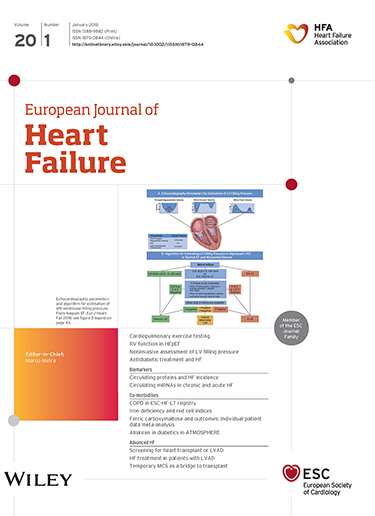芬那烯酮、慢性阻塞性肺疾病和心力衰竭伴射血分数轻度降低或保留:FINEARTS - HF试验的预先指定分析
IF 16.9
1区 医学
Q1 CARDIAC & CARDIOVASCULAR SYSTEMS
引用次数: 0
摘要
慢性阻塞性肺疾病(COPD)与射血分数轻度降低或保持的心力衰竭(HF)预后较差相关(HFmrEF/HFpEF)。一项对TOPCAT的事后分析表明,甾体矿物皮质激素受体拮抗剂(MRA)螺内酯的有效性可能会因肺部疾病而改变,对COPD/哮喘患者有更大的益处。根据FINEARTS‐HF预先指定的COPD状态分析,我们检查了非甾体MRA, finerenone与安慰剂相比的效果。方法和结果研究人员报告了COPD病史。主要终点是心血管死亡和总心衰恶化事件的综合。在FINEARTS‐HF随机分组的6001例患者中,773例(12.9%)患有COPD。与非COPD患者相比,COPD患者有更多的不良临床特征,包括更差的纽约心脏协会分级和堪萨斯城心肌病问卷(KCCQ)评分,更多的HF住院史,房颤/扑动,肥胖,外周动脉疾病和高血压,以及高敏感性肌钙蛋白T水平升高。COPD患者发生主要终点的风险较高(调整后的比率[RR] 1.44, 95%可信区间[CI] 1.21-1.71)。芬尼酮对主要结局的益处与COPD状态无关(无COPD: RR 0.84 [95% CI 0.73-0.97];Copd: 0.84 [95% ci 0.61-1.16];p交互作用= 0.93)。所有次要结果也观察到一致的效果。芬纳酮从基线到12个月改善COPD患者和非COPD患者的KCCQ总症状评分的程度相似(p相互作用= 0.46)。结论在HFmrEF/HFpEF患者中,芬尼酮对临床事件和症状的有益作用是一致的,与COPD状态无关。临床试验注册:ClinicalTrials.gov ID NCT04435626。本文章由计算机程序翻译,如有差异,请以英文原文为准。
Finerenone, chronic obstructive pulmonary disease, and heart failure with mildly reduced or preserved ejection fraction: A prespecified analysis of the FINEARTS‐HF trial
AimsChronic obstructive pulmonary disease (COPD) is associated with worse outcomes in heart failure (HF) with mildly reduced or preserved ejection fraction (HFmrEF/HFpEF). A post hoc analysis of TOPCAT suggested that the effectiveness of the steroidal mineralocorticoid receptor antagonist (MRA), spironolactone, may be modified by pulmonary disease, with a greater benefit in patients with COPD/asthma. We examined the effects of the non‐steroidal MRA, finerenone, compared to placebo, according to COPD status in a prespecified analysis of FINEARTS‐HF.Methods and resultsA history of COPD was investigator‐reported. The primary outcome was the composite of cardiovascular death and total worsening HF events. Of the 6001 patients randomized in FINEARTS‐HF, 773 patients (12.9%) had COPD. Compared to patients without COPD, those with COPD had more adverse clinical features, including worse New York Heart Association class and Kansas City Cardiomyopathy Questionnaire (KCCQ) scores, more prior HF hospitalization, atrial fibrillation/flutter, obesity, peripheral artery disease, and hypertension, as well as elevated high‐sensitivity troponin T levels. Patients with COPD had a higher risk of the primary endpoint (adjusted rate ratio [RR] 1.44, 95% confidence interval [CI] 1.21–1.71). The benefit of finerenone on the primary outcome was consistent irrespective of COPD status (no COPD: RR 0.84 [95% CI 0.73–0.97]; COPD: 0.84 [95% CI 0.61–1.16]; p interaction = 0.93). Consistent effects were also observed for all secondary outcomes. Finerenone improved KCCQ total symptom score from baseline to 12 months to a similar extent in patients with and without COPD (p interaction = 0.46).ConclusionIn patients with HFmrEF/HFpEF, the beneficial effects of finerenone on clinical events and symptoms were consistent, regardless of COPD status.Clinical Trial Registration: ClinicalTrials.gov ID NCT04435626.
求助全文
通过发布文献求助,成功后即可免费获取论文全文。
去求助
来源期刊

European Journal of Heart Failure
医学-心血管系统
CiteScore
27.30
自引率
11.50%
发文量
365
审稿时长
1 months
期刊介绍:
European Journal of Heart Failure is an international journal dedicated to advancing knowledge in the field of heart failure management. The journal publishes reviews and editorials aimed at improving understanding, prevention, investigation, and treatment of heart failure. It covers various disciplines such as molecular and cellular biology, pathology, physiology, electrophysiology, pharmacology, clinical sciences, social sciences, and population sciences. The journal welcomes submissions of manuscripts on basic, clinical, and population sciences, as well as original contributions on nursing, care of the elderly, primary care, health economics, and other related specialist fields. It is published monthly and has a readership that includes cardiologists, emergency room physicians, intensivists, internists, general physicians, cardiac nurses, diabetologists, epidemiologists, basic scientists focusing on cardiovascular research, and those working in rehabilitation. The journal is abstracted and indexed in various databases such as Academic Search, Embase, MEDLINE/PubMed, and Science Citation Index.
 求助内容:
求助内容: 应助结果提醒方式:
应助结果提醒方式:


